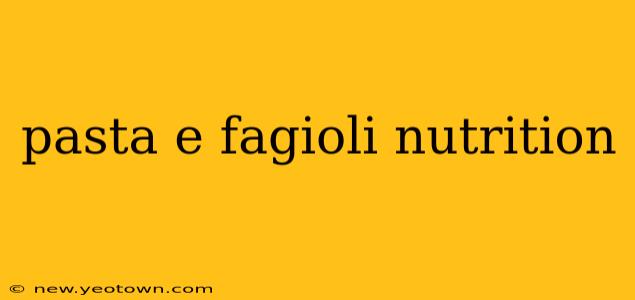Pasta e fagioli, the classic Italian soup of pasta and beans, is more than just a comforting meal; it's a nutritional powerhouse. This beloved dish, passed down through generations, offers a satisfying blend of carbohydrates, protein, and fiber, making it a surprisingly healthy and delicious choice. But what exactly is the nutritional breakdown, and how does it benefit your body? Let's dive in.
What are the main nutritional benefits of pasta e fagioli?
Pasta e fagioli's nutritional profile shines thanks to its key ingredients. The beans provide a significant source of plant-based protein, crucial for building and repairing tissues. They're also packed with fiber, which aids digestion, promotes satiety, and helps regulate blood sugar levels. The pasta contributes carbohydrates for energy, while the vegetables added (often carrots, celery, and onions) contribute vitamins and minerals. This combination creates a well-rounded meal that leaves you feeling full and energized.
How many calories are in a serving of pasta e fagioli?
The calorie count of pasta e fagioli can vary significantly depending on the recipe and serving size. A typical serving might range from 250 to 400 calories, but this can increase with the addition of richer ingredients like pancetta or sausage. Using whole wheat pasta and minimizing added fats will keep the calorie count lower. Remember, always check the nutritional information based on your specific recipe and portion size.
Is pasta e fagioli a good source of protein?
Absolutely! The beans are the stars here, offering a substantial amount of protein. Legumes like cannellini beans or borlotti beans, commonly used in pasta e fagioli, are excellent sources of plant-based protein. This makes the soup a great option for vegetarians and vegans looking to increase their protein intake. The combination of beans and pasta provides a complete protein profile, containing all essential amino acids.
What are the best types of beans to use in pasta e fagioli?
While many bean varieties work wonderfully, cannellini beans and borlotti beans are particularly popular choices. Cannellini beans provide a creamy texture and subtle flavor, while borlotti beans offer a slightly firmer bite and a richer taste. Ultimately, the best bean for you depends on your personal preferences. Experiment with different types to discover your favorite!
Is pasta e fagioli a healthy meal option?
Yes, when prepared in a balanced way, pasta e fagioli is a fantastically healthy meal. The abundance of fiber, protein, and essential nutrients makes it a nutritious choice. However, be mindful of added fats and sodium. Using fresh ingredients, minimizing added salt, and opting for whole wheat pasta contributes to a healthier overall outcome. This hearty soup can easily be incorporated into a balanced diet.
Can pasta e fagioli be part of a weight loss diet?
Absolutely! The high fiber content in pasta e fagioli promotes fullness and helps regulate appetite. This can aid in weight management by reducing overall calorie intake. Choosing leaner preparations, such as avoiding excessive amounts of olive oil or fatty meats, will further assist weight loss goals.
What are the potential downsides of eating pasta e fagioli?
While generally healthy, some individuals might experience digestive discomfort if they consume large portions, especially if they are sensitive to legumes. Also, be mindful of the sodium content; some recipes can be quite salty. If you have specific dietary concerns or restrictions, always check the ingredients and adjust the recipe to suit your needs.
In conclusion, pasta e fagioli is a delicious and nutritious meal that offers a wide range of health benefits. It's a flexible dish, allowing for various ingredient modifications to cater to individual tastes and dietary preferences. Enjoy this hearty and wholesome soup as part of a balanced lifestyle.

